As touched upon in our previous articles, we noticed that male is considered the default gender in LEGO minifigs. Given that we found a number of neutral heads without any gender-identifiable keywords associated with them, an interesting question that follows is, are neutral heads actually ‘neutral’? That is, are they really being used for minifigs of all genders? If not, what is the gender distribution of the minifigures with these ‘neutral’ heads?
To answer the questions above, we looked at minifigs in the Town category released within the most recent years (2017 — July 2022) for the scope of this analysis. We chose Town as a starting point because it features ‘normal’ people and their day-to-day lives rather than an abundance of aliens and fantasies as in some IP themes (e.g. films and movie series like Star Wars, Harry Potter, and Ninjago). Also, Town is currently the most gender-equitable theme.
Data Analysis
- We scraped descriptions of heads from Bricklink for all minifigs in Town within 2017-2022 and did a preliminary gender classification:
- female if “Female” is present in description
- male if “beard”, “goatee”, “sideburns”, “moustache”, “stubble”, or ” male” is present in description
- neutral otherwise
- We filtered to just the neutral heads (there are 65 unique neutral heads).
- We scraped descriptions of all the minifigs carrying each of these 65 neutral heads (there are 771 total minifigs, excluding non-humans – “Ghost”, “Skeleton”, “Clown”).
- We started out with the generic keywords (like those mentioned above). Then, we filtered to the remaining neutral heads and checked for names and other gender-identifying adjectives/position names that are less common. Repeating this process, we classified these “neutral” minifigures by their underlying gender:
- Female if description contains: “mom”, “ballerina”, “barista”, “female”, “woman”, “girl”, “lady”, “ponytail”, “little red”, “sally”, “madison”, “necklace”
- Male if description contains: “Male”, “Beard”, “Goatee”, “Sideburns”, “Moustache”, “Stubble”, “Man”, “Son”, “Dad”, “Guy”, “Father”, “Uncle”, “Salesman”, “Businessman”, “Dareth”, “Chad”, “Rocky”, “Si”, “Ronny”, “Chan Kong-Sang”, “Jia”, “Groom”, “Chase McCain”, “Hans Christian Andersen”, “Merman”, “Santa”, “Billy”, “Lil’ Nelson”, “Tito”, “Jack”, “Robin”, “Tommy”, “Wade”, “Lee”, “Paul”, “Duke”, “Wizard”, “Boy”
- Neutral otherwise
Results & Findings
Summary of Gender Distribution:
- 100 Female
- 361 Male
- 310 Neutral
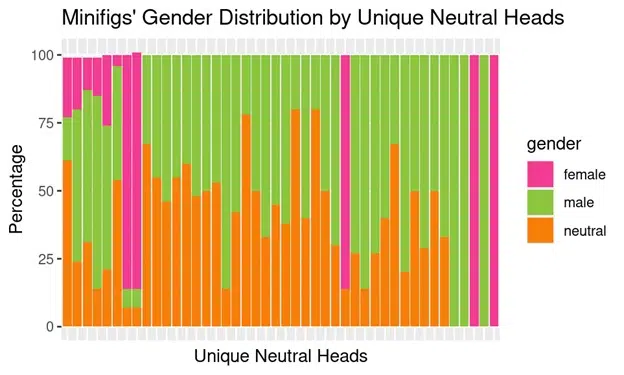
Interestingly, not a single neutral head is actually only used for neutral-gendered minifigs. Most neutral heads are used for about half of the time male and half of the time neutral minifigs. Overall, relatively few heads are used for female minifigs; and those that are are mostly only used for females a small percentage of the time. (Some of the bars are not exactly adding up to 100% due to rounding.)
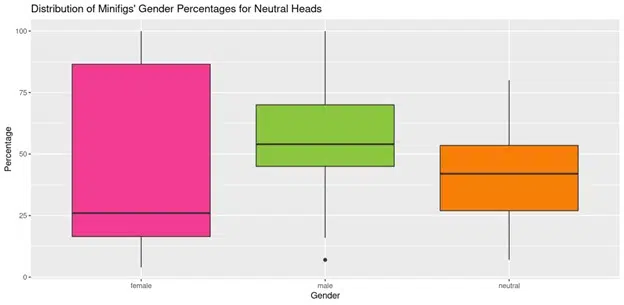
This graph is based on the same data but highlights the distribution of the percentages by each gender group rather than each individual head. The vertical black line shows the range of the percentage (the range covered between the maximum percentage and the minimum percentage). The horizontal black line in the middle of the colored boxes shows the median percentage of the corresponding gender. And the two horizontal lines encasing the upper- and lower- boundaries of the boxes represent the 75th and 25th percentile, respectively, of the percentages in each gender. The difference between the 75th and 25th percentile, or the height of the boxes, is called the interquartile range (IQR).
We can see that the median percentage for females is far lower than medians for males and neutral minifigs. Females also have a much wider IQR, meaning that there is more variation in the percentages neutral heads have been used on female minifigs than they have been on male or neutral ones.
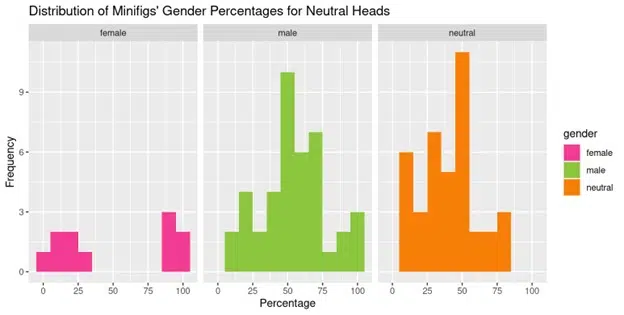
When we see a more detailed visualization of the distributions, it is notable that all heads used for females are used for females either for a very small percentage of the time (0%-25%) or a very large percentage of the time (85%-100%). In-between percentages are missing. Whereas, male and neutral distributions are much more symmetrical and both peak around 50%.
What does a 100%-female/male head look like?
Wondering what some of the most gender-specific and/or gender-non-specific heads look like (even though all the heads are neutral)? Let’s take a closer look at them.
Snapshot of main findings:
- All neutral heads that are used mostly (>85%) for female minifigs are child heads
- 2 out of the 3 neutral heads used only for male minifigs are also child heads
- 1 neutral head was used for an older man, no neutral heads were used for older women
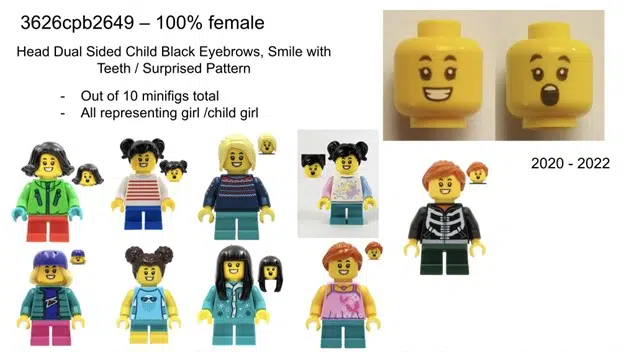
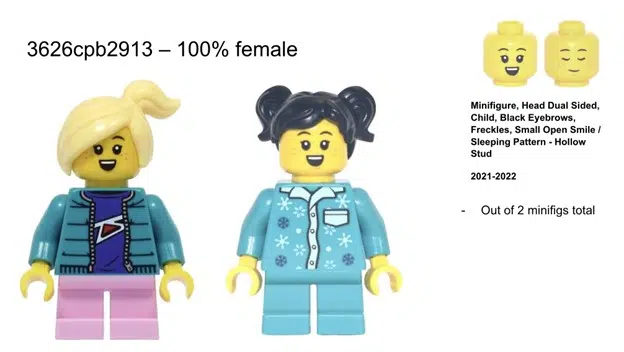
Notice that these two – and only two – 100%-female heads are both child heads.
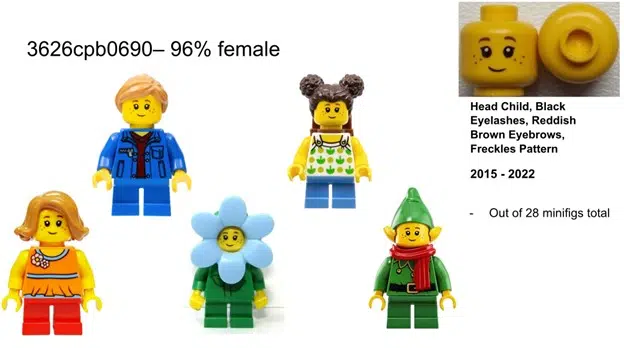
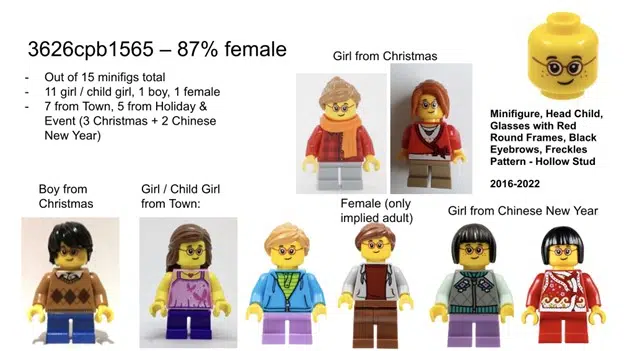
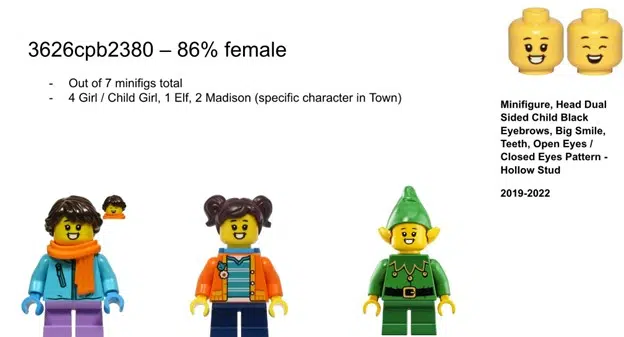
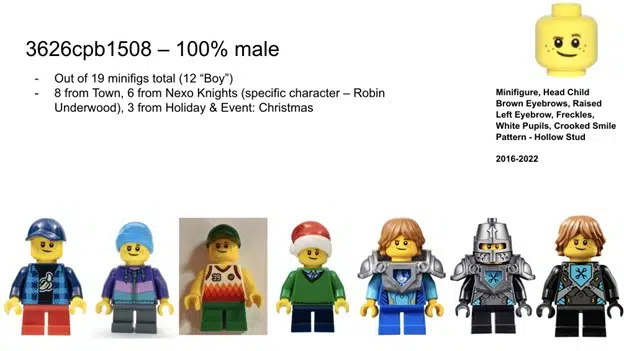
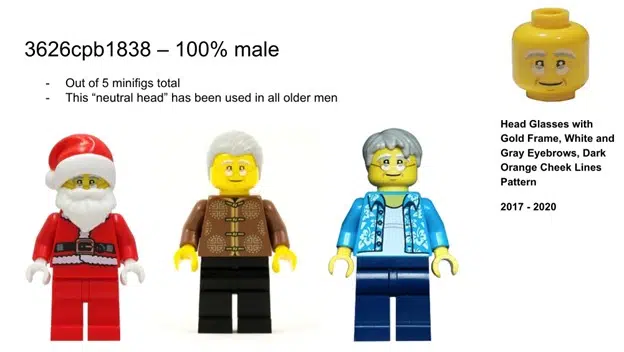
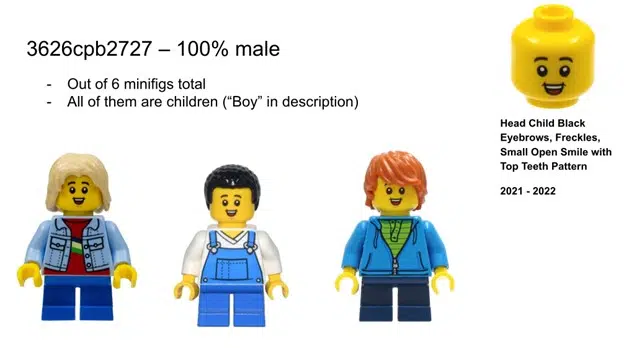
What do “Neutral” minifigs look like?
Three neutral heads that were used the most (percentage-wise: 80%, 80%, 78%) for “truly neutral” minifigs:
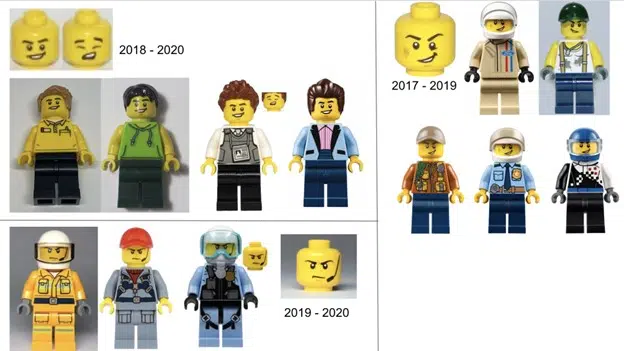
Looking back at the question we started out with — are neutral heads actually ‘neutral’? — our findings would lead us towards a negative answer. Neutral heads are not only being used far less in female minifigs (by count of unique heads) but also polarized (either very small or very large percentage-wise) for those that are indeed being used in females, especially comparing to how male minifigs are being represented in almost all neutral heads. This highlights the need for LEGO to create more explicitly gender-neutral minifigs and stop regarding male as the default.


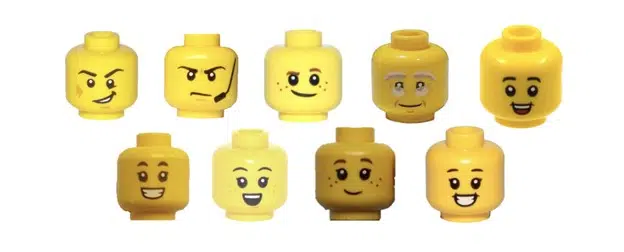
2 comments
Jared
Having a bit of difficulty parsing this article and will likely need to go back and read the methods and the data a few more times before I can articulate what feels off about it, but for now I just want to mention that in the first line there is the text, “ As touched upon in our previous articles (link to the articles)”. I think it was an oversight, but if the author or editorial team could go back and add the links where those parentheses are, it would be helpful to readers. Thanks!
Lara G
Hey! Clowns are humans too.